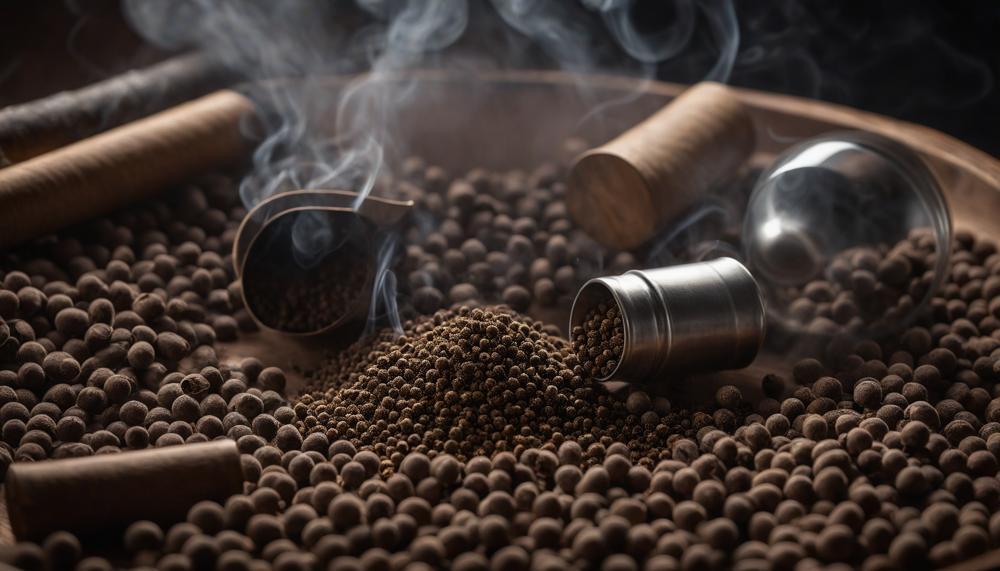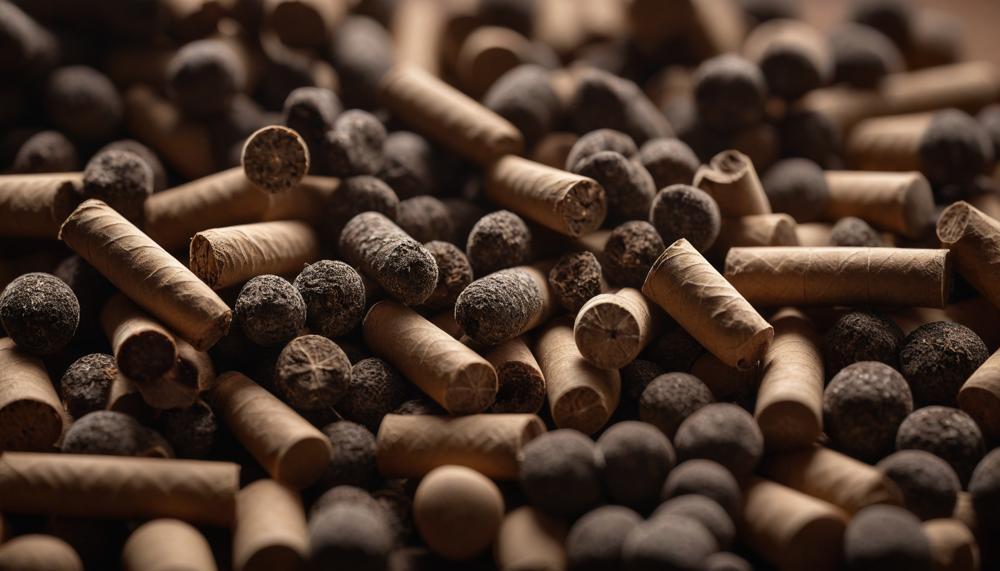Yes, you can use pellets in various smokers, but the experience and results will differ depending on the type of smoker you have. Pellets are a versatile fuel and flavor source growing in popularity for outdoor cooking enthusiasts. While pellet smokers are designed specifically for their use, allowing precise temperature control and a steady flow of smoke, other smokers and grills can also utilize pellets to enhance the flavor profile of your barbecue.
In a pellet smoker, the process is seamless: wood pellets are poured into a hopper and automatically fed into a burn pot, producing consistent heat and smoke. This method has won favor in barbecue competitions for its efficiency and the unique flavors it imparts. However, you can also use pellets in charcoal smokers or grills by adding them to the charcoal, which can enhance the smoky flavor of your meat, albeit with less precision and convenience.
Key Takeaways:
- Versatility: Pellets can be used in different types of smokers and grills, not just pellet smokers.
- Flavor Profiles: Various mixtures of hardwoods and fruitwoods in pellets offer unique flavors.
- Efficiency: Pellet smokers provide consistent heat and smoke, ideal for competitions.
- Experimentation: Both pellet and charcoal smokers allow for trying different wood pellet flavors.
- Quality: High-quality pellets, such as those from B andamp; B Charcoal, are recommended for the best results.
By understanding how to use pellets effectively in your smoker, you can elevate your barbecue game, experimenting with different flavors and techniques to achieve mouth-watering results.
Contents
Understanding Wood Pellets:What Are Wood Pellets?
Wood pellets are small, cylindrical pieces of compressed wood made from sawdust and other wood by-products. They serve as a clean, efficient fuel source, especially in outdoor cooking.
How Are Wood Pellets Used in Smokers?
Wood pellets are primarily used in pellet smokers, which have become a favorite among barbecue enthusiasts and professionals alike. Here’s how they’re used:
- Hopper Loading: Wood pellets are poured into a hopper attached to the smoker.
- Automatic Feeding: The smoker’s auger automatically feeds the pellets into a burn pot, where they are ignited to create heat and smoke.
- Temperature Control: Most pellet smokers feature digital controls that maintain a consistent temperature by adjusting the pellet feed rate.
- Smoke Flavor: Different types of wood pellets (oak, hickory, mesquite, fruitwoods) impart unique flavors to the meat.
Pellets can also be used in charcoal smokers or traditional grills to enhance the smoke flavor. By placing a handful of pellets on the charcoal, you can achieve a richer, more complex taste.
Benefits of Using Wood Pellets
| Clean Burning | Wood pellets produce minimal ash and smoke, making them an eco-friendly fuel source. | Learn More |
| Consistent Heat | Pellet smokers maintain steady temperatures, crucial for low-and-slow cooking. | B and B Charcoal |
| Versatility | Available in various flavors, wood pellets allow for creative and diverse culinary experiments. | Pitmasters |
Wood pellets have revolutionised barbecue by providing a reliable and flavorful fuel source that caters to both novice backyard cooks and seasoned pitmasters.
Choosing the right wood pellet
Choosing the right wood pellet for your smoker involves several key factors that can significantly impact the flavor, cooking efficiency, and overall grilling experience. Here are the critical considerations:

Type of Wood:
Different wood types impart distinct flavors to food, enhancing specific meats. For instance:
- Hickory: Strong, hearty flavor, ideal for beef and pork.
- Maple: Sweet, subtle taste, great for poultry and pork.
- Mesquite: Intense, earthy flavor, perfect for red meats.
- Oak: Mild flavor, versatile for most meats.
Quality and Composition:
Opt for pellets made from 100% natural hardwood without fillers or binders. High-quality pellets ensure consistent heat and smoke, enhancing the taste and cooking efficiency.
Understanding Wood Nuances:
Knowing the flavor profile of each wood type helps in pairing with different meats to achieve the desired taste.
Proper Storage:
Store pellets in an airtight container to prevent moisture absorption, which can compromise their quality and performance.
Temperature Control:
Consistent temperature is essential for efficient burning and optimal smoke production. High-quality pellets burn evenly and help maintain steady heat.
Smoke Density Management:
Pellets that produce balanced smoke prevent a bitter taste. Dense smoke can overpower the meat’s natural flavors, so choose pellets that offer a smooth, balanced smoke output.
Pellet Size and Composition:
Uniform pellet size and minimal ash production are indicators of superior quality. This ensures efficient burning and less frequent cleaning of the smoker.
Cost-Effectiveness:
While cheaper options might be tempting, investing in high-quality pellets offers better burn efficiency and flavor payoff in the long run.
Using Wood Pellets in an Offset Smoker:
The short answer is yes, you can use wood pellets in an offset smoker instead of traditional wood logs.
Wood pellets offer several advantages that make them an excellent alternative:
| Aspect | Wood Pellets | Wood Logs |
| Heat Consistency | Highly consistent | Variable, depends on log size and type |
| Smoke Cleanliness | Cleaner smoke | More soot and creosote |
| Storage | Compact and easy | Bulky, requires more space |
| Efficiency | High | Moderate |
| Environmental Impact | More sustainable | Less sustainable |
| Flavor Variety | Wide range (e.g., hickory, mesquite, apple) | Limited by wood availability |
So, using wood pellets in an offset smoker can provide you with consistent heat, cleaner smoke, and a variety of flavours. They are an efficient and environmentally friendly alternative to traditional wood logs, enhancing your barbecue experience.
Extra tips and tricks
Extra tips and tricks for using pellets in a smoker to enhance the grilling experience include:
- Use a Thermometer: Always cook to temperature, not time. Investing in a good meat thermometer ensures your food is cooked perfectly every time. This is especially crucial for larger cuts of meat where precise internal temperatures can mean the difference between juicy and dry.
- Regular Cleaning: Clean your smoker every 1-3 cooks. This not only helps in maintaining optimal performance but also prevents any build-up of ash or grease that can affect the taste of your food. Here’s a handy guide on cleaning your smoker: How to Clean Your Smoker.
- Experiment with Wood Pellets: Different wood pellets impart varying levels of smoke flavor. For example, hickory offers a strong, bold flavor, while applewood is milder and slightly sweet. Try mixing different pellets to create unique flavor profiles for your dishes.
- Utilize Accessories: Enhance your cooking options by using accessories like smoke tubes, which can add extra smoke flavor, and upper racks, which increase your cooking surface area. These can be particularly useful for large gatherings or when cooking multiple types of food simultaneously.
- Diversify Your Menu: Don’t limit yourself to just meat and vegetables. Your pellet grill is incredibly versatile and can be used to make pizza, bake bread, or even grill desserts. This expands your grilling repertoire and makes your outdoor cooking sessions more exciting.
Conclusion
When considering the use of wood pellets in smokers, flexibility and flavor enhancement stand out. Pellets aren’t limited to just pellet smokers; they can also elevate the cooking experience in charcoal smokers and grills. Designed for pellet smokers, they provide precise temperature control and consistent smoke, ideal for competition-level barbecue. However, adding pellets to charcoal in other smokers imparts unique flavors, albeit with less precision.
The process in a pellet smoker is straightforward: load the pellets into the hopper, and the smoker handles the rest, maintaining consistent heat and producing flavorful smoke. Charcoal smokers, on the other hand, can benefit from adding pellets to the coals, enriching the meat’s taste.
Key highlights include:
- Versatility: Pellets can be used across different smokers, not just pellet-specific models.
- Flavor Options: Hardwood and fruitwood blends offer a spectrum of flavors.
- Efficiency: Pellet smokers are renowned for their steady heat and smoke output, making them a favorite for serious barbecue enthusiasts.
- Experimentation: Both pellet and charcoal smokers allow culinary creativity with different pellet flavors.
- Quality Matters: Using high-quality pellets like B andamp; B Charcoal ensures the best results.






